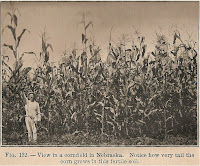Farming in the early 1920s
I love the old-time photographs in my 1920 World Geographies book. Here are a couple of farming images from the 1920s or before. Today, the tractor above would be over 85 years old, but at that time, it was the cutting edge of farm technology. The text has these comments:
On these large farms [in the upper Great Plains] a particularly valuable help to the farmer is the modern farm tractor. This machine burns gasoline or other forms of petroleum, is very strongly built, and takes the place of many men and horses in hauling heavy loads and performing difficult tasks. With it a dozen plows can be pulled at once; plowing and harrowing can be performed in one operation; or the engine may be used to pump water or to saw wood. Some of them have high wheels; but many of them creep along the roughest ground with "caterpillar" tread like the mighty Army "tanks."
Source of the above quotation and the accompanying images: World Geographies: Second Book, by Ralph S. Tarr and Frank M. McMurry, copyrighted in 1920. Published in 1922 by The MacMillan Company, New York
Look how tall the corn is in the photo below from this old book. The tallest stalks must be 12 to 15 feet in height. I remember my parents talking about the tall corn they remembered from their childhood.
Notice also the variation in the size of the plants. The seed was open-pollinated in those days, and every plant was different. Today, corn seed producers tightly control the pollination of each plant to produce tons of seed that is exactly identical (or as identical as possible.) That's why every plant in a modern cornfield is pretty much the same size.
Nowadays, field corn has been hybridized and selected for size of ear, disease resistance, and days to harvest. If we start using the entire corn plant to produce biofuels, we may start seeing tall corn like this again!
 A Nebraska farmer of the early 20th century
A Nebraska farmer of the early 20th centurystands in a field of tall corn.

4 comments:
"The corn is as high as an elephant's eye, and it looks like it's climbin' clear up to the sky": As a native New Yorker now in Illinois, I've been puzzled by that lyric -- there's nothing that high in these cornfields. But after seeing the photo in your post, the lyric finally makes sense to me. Thanks, Genevieve.
Thanks for stopping by, Michael. Maybe Rodgers & Hammerstein had some farm advisors when they wrote Oklahoma because they were both New Yorkers too. :)
doesn't it look closer to 20 feet near the tassel tip? where did the photo come from? maybe it says.
If the man is six feet tall, then the tip of the tassel of the tallest stalk would probably be over 18 feet tall. If he's 5 feet tall, then the tallest stalk would be over 15 feet tall. So I agree -- I probably underestimated. There is no further information about the photo in the book -- just the caption that appears under the photo.
Post a Comment